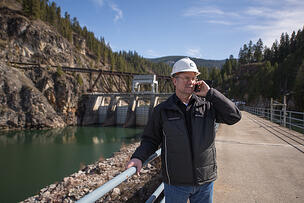(Part One in a Series of Four Topics)
Replacing or upgrading existing hydropower turbines is no small task. You’ll face a number of challenges including the sourcing of parts from all over the world, remote work locations, internal staff turnover, difficult contractual relationships, deadlines, and budget constraints. There will be plenty of reasons you won’t sleep at night.
Your staff has likely operated and maintained a successful plant for several decades, so they are no doubt very knowledgeable and experienced. But have they managed a hydropower facility AND a turbine replacement or upgrade project at the same time? How will you maintain operations and simultaneously advance progress on a rebuild project with new staff? Managing plant operations is very different from managing a multi-million dollar construction project.
In this series I’ll outline a number of key issues you should consider before starting your turbine replacement project. My goal is to provide you with some of the tools you’ll need to better manage these projects. I also hope these tips will help you to sleep better at night.
The topics will include:
- Risk Management
- Geographic Challenges
- Project Communication
- Staffing Capacity
In this first article of my four part series I’ll discuss Risk Management.
Hydro turbine replacement and upgrade projects are complicated. Risk associated with these projects can be mitigated when clearly identified, then considered in an effective contract, and finally managed by a diligent project manager.
Identify Risks with a Constructability Review
Again, the first step in managing risks is to identify and understand them. This is why a constructability review is important. Whether performed internally or by an outside construction management professional, your independent constructibility review should be extensive and adequately funded. The design team may be very good and thorough, but have they managed a multi-million dollar upgrade through construction? A constructability review will identify design, phasing, or staging issues and decrease your design related risk. But more important, a constructability review will identify construction risks so they can be considered by your project management, legal, and procurement team during the contracting phase.
Prepare an Effective Contract
An effective contract will then assign these identified risks to the party best suited to manage them. As examples, the contract should assign to the contractor risks related to delivery acceptance, which they are best able to control. Conversely, the owner should own design related risks when they have performed or procured the project design. It’s imperative that these responsibilities are outlined clearly and consistently in all contract documents. Clarity during the contracting phase creates a solid foundation for project success.
Once crafted, these contracts become very complicated, requiring extensive contractor submittals, Testing and Inspection Plans for offsite manufacturing and some onsite assembly, prevailing wage documentation, and advanced CPM scheduling and reporting. To top it off, these dynamic projects require contract provisions that can accommodate unexpected project changes. These provisions ensure that risks are assigned and responsibilities are clear.
Choose the Right Project Manager
Sound project management is imperative since the contract is only effective if the responsibilities laid out in the contract are fully managed. It's not an easy job. An effective project manager must be firm-but-fair. He or she must document compliance to contract responsibilities by putting in place the necessary inspection staff, technology, and procedures. They must also possess clear and consistent communication skills and knowledge of agency standards and permitting guidelines.
In a recent turbine replacement project, I worked with the owner to make available to the contractor additional space for the storage of materials and equipment. Because parts were being sourced from all over the world, adequate storage space gave the construction team options for the logistics of delivery timing. However, as construction manager, I also ensured that responsibilities for delivery acceptance of materials remained clear. This simple example illustrates the importance of solid contracts and diligent project management.
Assess Your Team
The very first step, of course, is to assess the strengths of your project team to determine whether you have the internal expertise and resources needed to prepare a constructability review, scrutinize contracts, and/or provide effective project management.
Don’t underestimate the power of hiring a third party Construction Manager. I say this because I’ve encountered several projects that could have realized considerable time and financial savings had a Construction / Project Manager been retained from the beginning of the project. The value a Construction Manager adds to a project often increases exponentially when that person is involved early in the project during the design and contracting phases.
Email me or call me! I’d love to hear about your experience managing similar projects. I’d also be interested in how you’ve staffed the construction management expertise needed for these projects.
To read part 2 in this series, click here.



Leave us a comment below